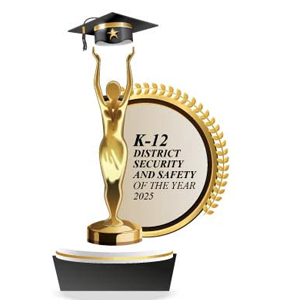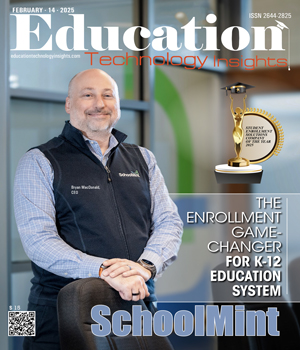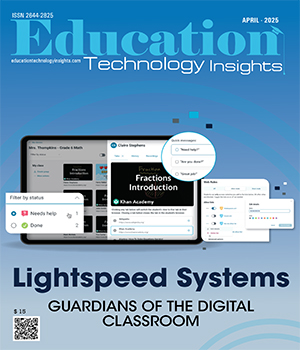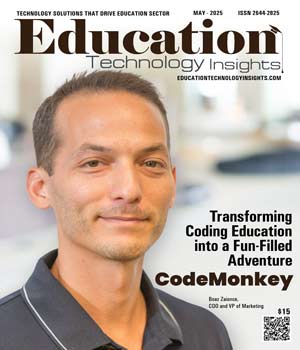THANK YOU FOR SUBSCRIBING
Be first to read the latest tech news, Industry Leader's Insights, and CIO interviews of medium and large enterprises exclusively from Education Technology Insights
AI in Our Schools - The Moving Target!
Julie Garcia, Senior Director of STEM, San Diego Unified School District
Navigating AI in Education Julie Garcia, Senior Director of STEM, San Diego Unified School District
Julie Garcia, Senior Director of STEM, San Diego Unified School District
Let’s take a step back - way back to when classrooms had typewriters with the keys blacked out. Feels like a long time ago, right? Then -came computer labs where students would leave their classrooms to learn typing, word processing, maybe write an essay, or even do something a little creative. The real game-changer was when devices started making their way into classrooms - first as shared stations, then on carts, and in many cases, after COVID, one device for each student, making technology an everyday part of learning. This shift didn’t happen overnight - it took about 30 years. So where are we now?
Most districts were in different places when schools closed for the pandemic. Remember the conversations? What an opportunity to expand technology for our teachers, and this may lead to accelerated innovation.As districts led their educators out of the pandemic, many transitioned to 1:1 device programs. Still, lingering challenges existed. Some teachers worried about too much screen time and limited technology access to students, while others perhaps leaned in too much, losing the human connection. As if that wasnt enough, while districts were navigating these new scenarios, along came Artificial Intelligence, AI, a moving target.
AI is moving at a much quicker rate than any other evolving technology or model. The time from computer labs to 1:1 programs spanned but now we have an accelerated growth of AI. Although companies, organizations, and even school districts have differing opinions on how and why they incorporate AI, our goal is for students and teachers to understand it, and be literate in using it responsibly. But with these changes happening so quickly, how do we adapt while keeping our eye on the target?
From the start, San Diego Unifieds Instructional Technology team kept focused on the target when it came to AI. We started by working with schools to help educators From the start, San Diego Unifieds Instructional Technology team kept focused on the target when it came to AI. We started by working with schools to help educators see the value in it. At first, educator’s worried students may misuse it and some even feared AI might take over their jobs. We addressed the issue by reminding teachers that no tool can replace the connection and care they bring to their students. Tools should enhance the amazing work educators already do - not replace it. As we worked with educators and the excitement started to build, we focused on showing them how AI can streamline their workflow, and more importantly how to design learning experiences that teach students proper use, agency, and skills needed for a future with AI. Of course, because AI keeps evolving, our work with teachers around this new technology is a work in progress because no playbook exists on something that’s in a constant state of flux.
As the Instructional Technology team learned more about AI, larger issues arose such as student security, privacy, and how we as a district are using AI, and why. Our team knew it had to do something to inform educators and staff of appropriate use, support teachers in using AI tools, and ensure students have a safe space for using AI to their advantage.
“No tool can replace the connection and care teachers bring to their students—tools should enhance the amazing work educators already do, not replace it”
As a next step, the Instructional Technology Department teamed up with the Integrated Technology Division (IT), and a new partner, AIEDU to design a plan for a district wide Task Force to address acceptable use of AI system wide. This Task Force would be unique in that it would include constituents from all over the district: teachers, principals, and counselors, to nursing, Integrated Technology (IT), Facilities Planning and Construction, Human Resources, Finance and even community members and students. The Goal? To wrap our heads around the benefits and risks of AI in our system and craft guidelines for responsible use. The first meeting took place in October, 2024 drawing over 60 staff members from a wide range of departments. As you can imagine, AI looks different across all district departments, making this a moving target from the start.
After the initial meetings and discussions around what AI is and how it impacts our work, the Task Force split into smaller work groups. The subgroups we created are focused on operations, educators, students, safety and security, and caregivers guidelines. It was important that there were educators in each of the subgroups so that our teachers and students are at the heart of the work. Each group, using templates, resources, and sample guidelines, tackled the big questions - what AI currently looks like, what it might look like, and what it definitely shouldn’t look like in their area of focus. To bring even more voices, we hosted a Town Hall where the community could learn about AI, its impact on students, and share their thoughts on what they want to see in the guidelines.
The work of these groups continues into the spring as they design guidelines. Feedback from leadership will provide insight as the teams take their next steps in engaging in a peer review protocol of each other’s work. At the same time, Board members will be invited to review and provide their thoughts on the guidelines as well. The end goal is to have a first version of AI Guidelines to the Board by summer 2025. The team understands how things are constantly changing, and are adapting the processes on the fly. That target? Yes, it keeps on moving!
As we all know, this landscape isn’t slowing down anytime soon. Next year, we will focus on professional learning, figuring out where AI fits into instructional materials and curriculum, and making sure everything aligns with the new guidelines. Our Acceptable Use Policy will remain intact, but reference to the AI guidelines will be added. We know we will need to come back to the drawing board for revisions and redesign but understand that its all part of the process to keep moving in the right direction.
Read Also
The Indispensable Role of Emotional Intelligence in K-12 Technology Leadership
Reimagining Learning in a Digital World
Simplifying Online Program Tuition: Residency-Based Pricing in a Digital Age
Empowering the Future of Online Learning: A Holistic Vision for Transformational Education
Transforming Education Through Technology Leadership
Preparing for Generation Alpha in the Age of AI

I agree We use cookies on this website to enhance your user experience. By clicking any link on this page you are giving your consent for us to set cookies. More info




















![Udemy [NASDAQ: UDMY]: Online Learning Transformed Udemy [NASDAQ: UDMY]: Online Learning Transformed](https://www.educationtechnologyinsights.com/company_logos/6-7cuaqksu.jpg)







